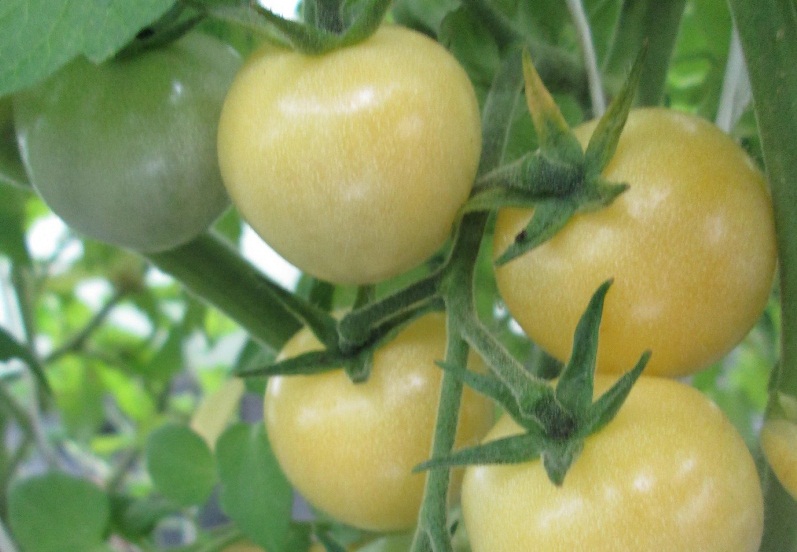 Tomato lovers try to grow varieties with fruits of different sizes and colors in order to give variety not only to the appearance of the plot, but also to their taste sensations.
Tomato lovers try to grow varieties with fruits of different sizes and colors in order to give variety not only to the appearance of the plot, but also to their taste sensations.
Tomato variety Italian ice will be of interest to both the small size of the fruit (like cherry), and the taste, and unusual color - ivory.
Content
Characterization and description of the variety
Variety characteristic:
- indeterminate;
- tall;
- mid-early;
- bush height - 1.5-2m;
- small fruited;
- storage - long;
- good safety during transportation;
- cultivation - greenhouse, open ground;
- stem formation - 2.
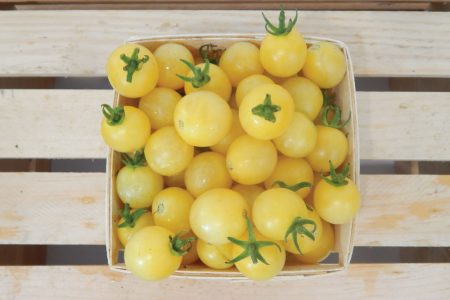
Description of the fruit:
- the shape is round;
- size is small;
- maturity color - ivory;
- weight - 15-20g;
- taste is sweet;
- peel - smooth, shiny;
- use - fresh, canning.
Features of growing tall tomatoes
Sowing seeds for seedlings - March 10-20, transplanting seedlings in a greenhouse - May 20-25 (areas in central Russia).
Seed preparation:
Important! Seeds of well-known producers are already calibrated and treated against infections.
- Sorting: Lower the seeds in a salt solution (30-40 g per 1000 ml), remove the floated ones, and rinse full and strong ones under the tap (put the seeds in a bag of gauze).
- Disinfection: for 20-30 minutes, place in a solution of potassium permanganate (1 g per 250 ml of water), rinse. A solution of this concentration has a dark purple color.
- Treat with a growth stimulator (according to instructions), the volume of which is twice as large, for six hours (temperature 18 °). Seed embryos awaken at the same time, disinfection occurs. Do not store the prepared solution.
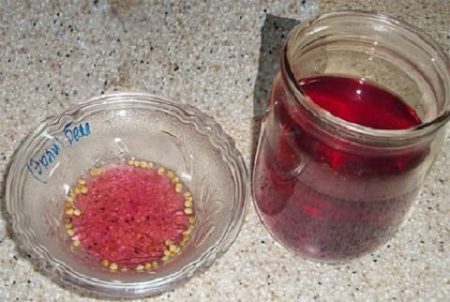
Soil preparation
- Mix equal parts of peat, humus, soddy soil; if the soil is loamy, add sawdust or river sand. Disinfect the prepared mixture in the oven, in the microwave oven at full capacity or in a bag, placing it in water 60 ° -70 ° (until cooling).
- Add 1 cup ash or a tablespoon of dolomite flour, nitrophosphate, urea and potassium per teaspoon to a bucket of the mixture.
- The ready-made soil mixture "Solanaceous", "Universal" is suitable.
Seeding and seedling care
- Containers for planting, if they have already been used, must be disinfected with a solution (35 °) of bleach (20 g per 1000 ml of water) or copper sulfate (10 g per 1000 ml of water).
- Fill clean and disinfected containers with soil, slightly compacting it, pour it with water or a solution of pale pink potassium permanganate.
- Spread the seeds with tweezers into recesses (holes or grooves), up to 1.5 cm deep, at a distance of 3 cm between them, sprinkle with soil and moisten with a spray bottle. When sowing in glasses, sow in every 2-3 seeds, leaving the strongest and strongest plant in the future (remove the weak ones).
- Cover the containers with glass, cellophane and put in heat (24 ° -26 °). After the appearance of the shoots, remove the film, place the seedlings for a week (or 4 days) in a cool place (15 ° -16 °). If the skin from the leaf is not opal (this happens with insufficient deepening or poor compaction of the soil), then you can moisten it.The skin left on the leaf can destroy the sprout.
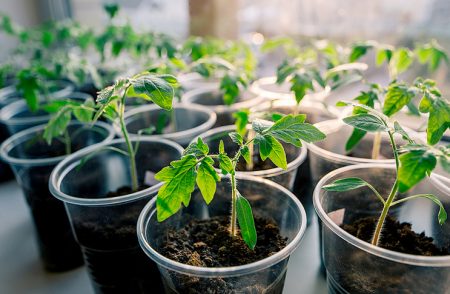
- While the earth is wet, watering is not carried out, then water each week with warm water in the morning. Sprinkle the strengthened seedlings with potassium permanganate or ash infusion.
Important! Excessive watering can cause the disease "black leg" and helps to draw out seedlings.
- The lack of lighting is compensated by fluorescent lamps.
- Pick plants with 2-3 real leaves are carried out on the 15-20th day, frail, damaged plants are rejected. When transplanting, the stem should be deepened into the ground to the cotyledonous leaves (subordinate roots are well formed). After that, pour the soil, trying not to get on the leaves, put the containers in a shaded place.
- To increase immunity, spray the stems and leaves with a solution of skim milk in water (1/2 tbsp per 1000 ml).
- Spray plants with a weak, thin stem and pale leaves with a solution of a teaspoon of urea in five liters of water and reduce the temperature to 12 ° -13 ° for a week. Spray with superphosphate extract and ash infusion with rapid leaf growth.
- At high seedlings (80-100cm), trim the upper part of the stem (25cm), remove one or two leaves from below, put in a glass of water. Transplant into the ground during sprouting of roots.
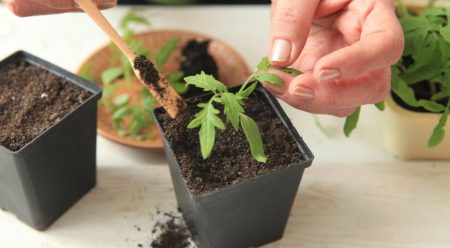
- Harden seedlings a week before transplantation, taking to the loggia, the veranda, first no more than three hours, and then - for 8-12 hours.
- Remove the lower leaves (two to three) five days before planting, a week later - treat from late blight.
- Bushes 25-35cm high with 8-10 leaves transplanted in the greenhouse.
Transplanting
- Planted in soil warmed up to 10 ° -15 ° - low temperatures inhibit the development of roots.
- Put a little humus, ½ handfuls of ash, a teaspoon of superphosphate in the wells, mix and spill with warm water. After planting, put the mulch on top.
- Plant tall tomatoes at a distance of 50-60cm between the bushes and, preferably, in one row.
- Garter plants to spend on 3-5 days, later repeating it when the stem grows.
Tomato care in the greenhouse
- Remove stepchildren 5cm long once a week, leaving a small stump (a new shoot does not grow). The procedure is carried out constantly.
- Leaves up to the 3rd brush are removed - this allows air to circulate better, evaporation is reduced, fruit ripening is accelerated. Remove 2-3 sheets at a time.
- In the middle of August, pinch the top (leave 2-3 leaves), remove the remaining flowers (the fruits will not have time to set).
- In spring, water once every ten days, in the summer - once a week (one bucket for three bushes). For better moisture, make punctures in the soil (pitchfork, peg), taking care not to damage the roots.
- Periodically loosen the earth - no crust forms.
- Reduce the amount of watering a month before harvesting the fruits and stop in 15-20 days - the fruits ripen faster and do not crack.
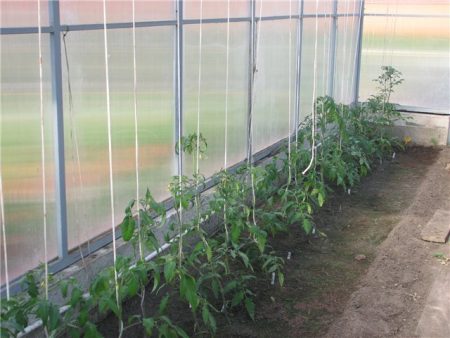
Advantages and disadvantages of tomato Italian ice
The advantages of Italian ice far exceed its disadvantages, which are inherent not only to this tomato, but also to other tall varieties.
Benefits:
- high nutritional value;
- decorative appeal;
- like both adults and children because of the small size, unusual coloring;
- high productivity;
- does not need fertilizers for the growth of the stem and fruits;
- efficient use of the area (the bush takes up little space);
- early ripening;
- fruiting to frost;
- compact form of a bush;
- the fruits are well stored and transported;
- fresh use and for canning.
Disadvantages: the need for pinching, garter bush and brushes.
Reviews
Leonid
Quite unexpectedly, I acquired a small-fruited variety of Italian ice. Cherry and this tomato were grown at the same time. The care was no different, but there are differences in taste: Italian ice is softer, more fresh.Fresh I like tomatoes with a more pronounced taste. I liked this variety very much in pickles and pickling - the taste becomes saturated. It can be grown for harvesting and for a change, decent productivity.
Sofia
I love unusual tomatoes, so I planted Italian ice. There are a lot of small tomatoes on the brush - it looks beautiful when everyone else is red. In the pickle, I tried to put whole brushes, it turned out great! In winter, put such beauty on a plate - your appetite will immediately appear. Canned fruits, not in the brush, also canned - pickled with spices. I liked the taste, I am satisfied.




 Low-growing tomatoes, without pinching: 5 of the most delicious varieties
Low-growing tomatoes, without pinching: 5 of the most delicious varieties Why tomato seedlings grow poorly
Why tomato seedlings grow poorly We grow a tomato in a shell
We grow a tomato in a shell Growing tomatoes without watering according to the method of Kazarin
Growing tomatoes without watering according to the method of Kazarin